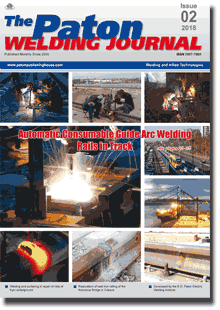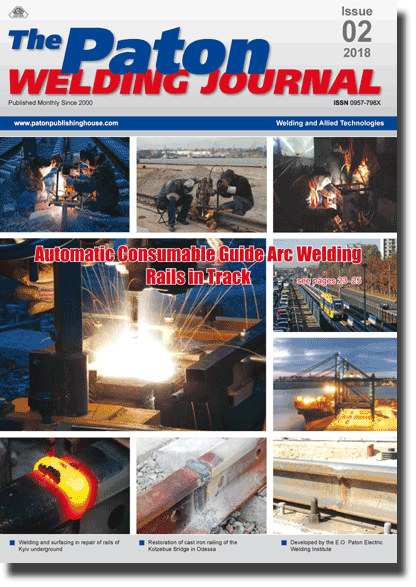| 2018 №02 (01) |
DOI of Article 10.15407/tpwj2018.02.02 |
2018 №02 (03) |

The Paton Welding Journal, 2018, #2, 7-13 pages
Effect of metal structure on service properties of high-strength steel welded joints produced using different methods of welding
L.I. Markashova, V.D. Poznyakov, V.D. Shelyagin, E.N. Berdnikova, A.V. Bernatsky and T.A. Alekseenko
E.O. Paton Electric Welding Institute of the NAS of Ukraine 11 Kazimir Malevich Str., 03150, Kyiv, Ukraine. E-mail: office@paton.kiev.ua
Abstract
Evaluations of effect of forming structures and phase constituents on change of the most significant mechanical properties of welded joints were carried out based on investigation of peculiarities of formation of structural parameters in welded joints of high-strength steel, produced by different methods of fusion welding (laser, arc and hybrid laser-arc). A role of structural factors (alloying, phase constituents, grain, subgrain structure, distribution and density of dislocations, phase precipitations, their size and nature of distribution) was shown in providing the optimum properties of the welded joints and their service reliability. It is shown that the most significant structural-phase parameters and factors, providing under operation conditions, the necessary complex of properties of welded joints, namely strength (sy), fracture toughness (K1C) and crack resistance (tin), are fineness of grain and subgrain structures; dispersion of phase precipitations at their uniform distribution; absence of extended dislocation accumulations — potential concentrators of internal stresses (zone of nucleation and propagation of cracks). 23 Ref., 6 Figures.
Keywords: laser welding, arc welding, hybrid laser-arc welding, high-strength steel, welded joints, structure, phase composition, mechanical properties, fracture toughness, crack resistance
Received: 04.12.17
Published: 15.03.18
References
- (1965) High-strength steel: Ed. by L.K. Gordienko. Moscow, Metallurgiya [in Russian].
- Houdremont, E. (1959) Special steels. Moscow, Metallurgizdat [in Russian].
- Shorshorov, M.Kh., Belov, V.V. (1972) Phase transformations and properties of steel in welding. Moscow, Nauka [in Russian].
- Madej, K., Jachym, R. (2017) Welding of high strength toughened structural steel S960QL. Biuletyn Instytutu Spawalnictwa, 2, 6–16. https://doi.org/10.17729/ebis.2017.2/1
- Rozanski, M., Stano, S., Grajcar, A. (2016) Effect of braze welding parameters on the structure and mechanical properties of joints made of steel CPW 800. Pt 1: Arc braze welding. Ibid., 6, 6–12.
- Cah, P., Salminen, A., Martikainen, J. (2010) Laser-arc hybrid welding processes (Review). The Paton Welding J., 6, 32–40.
- Kurc-Lisiecka, A., Lisiecki, A. (2017) Laser welding of the new grade of advanced high-strength steel DOMEX 960. Materials and Technology, 51(7), 199–204. https://doi.org/10.17222/mit.2015.158
- Liu, F., Yu, X., Huang, C. et al. (2015) Microstructure and mechanical properties of AerMet 100 ultra-high strength steel joints by laser welding. of Wuhan Univ. of Technology — Mater. Sci. Ed., 30(4), 827–830. https://doi.org/10.1007/s11595-015-1236-0
- Keehan, E., Zachrisson, J., Karlsson, L. (2010) Influence of cooling rate on microstructure and properties of high strength steel weld metal. and Technol. of Welding and Joining, 15, 233–238. https://doi.org/10.1179/136217110X12665048207692
- Svensson, L.-E. (2007) Microstructure and properties of high strength weld metals. Sci. Forum, 539–543, 3937–3942. https://doi.org/10.4028/www.scientific.net/MSF.539-543.3937
- Mikhoduj, L.I., Yushchenko, A.K., Poznyakov, V.D. et al. (1991) Weldability of high-strength steel 12GN3MFAYuDRSSh. Svarka, 11, 12–16 [in Russian].
- Markashova, L.I., Poznyakov, V.D., Berdnikova, E.N. et al. (2016) Structure and service properties of hybrid laser-arc welded joints of 14KhGN2MDAFB steel. The Paton Welding J., 5–6,104–113. https://doi.org/10.15407/tpwj2016.06.18
- Markashova, L.I., Poznyakov, V.D., Berdnikova, E.N. et al. (2014) Effect of structural factors on mechanical properties and crack resistance of welded joints of metals, alloys and composite materials. Ibid., 6–7, 22–28. https://doi.org/10.15407/tpwj2014.06.04
- Goldshtejn, M.I., Litvinov, V.S., Bronfin, B.M. (1986) Metallophysics of high-strength alloys. Moscow, Metallurgiya [in Russian]. Conrad, H. (1973) Model of strain strengthening for explanation of grain size effect on yielding of metal. Ultrafine grain in metals. Ed. by L.K. Gordienko. Moscow, Metallurgiya, 206–219 [in Russian].
- Petch, N.J. (1953) The cleavage strength of polycrystalline. Iron and Steel Inst., 173, 25–28.
- Orowan, E. (1954) Dislocation in metals. New York, AIME.
- Ashby, M.F. (1983) Mechanisms of deformation and fracture. Appl. Mech., 23, 117–177. https://doi.org/10.1016/S0065-2156(08)70243-6
- Busha, Yu., Karel, V., Longauer, C., Billy, I. (1977) About relation of yield strength of sorbite with medium size carbides. Fizika Metallov i Metallovedenie, 44(3), 604–610 [in Russian].
- Romaniv, O.N. (1979) Fracture toughness of structural steels. Moscow, Metallurgiya [in Russian].
- Stroh, A.N. (1954) The formation of cracks as a recoil of plastic flow. of the Roy. Soc. A, 223(1154), 404–415.
- Panin, V.E., Likhachev, V.A., Grinyaeva, Yu.V. (1985) Structural levels of deformation of solids. Siberian Depart., Nauka [in Russian].
- Conrad, H. (1963) Effect of grain size on the lower and flow stress of iron and steel. Acta Metallurgica, 11, 75–77. https://doi.org/10.1016/0001-6160(63)90134-2
Suggested Citation
L.I. Markashova, V.D. Poznyakov, V.D. Shelyagin, E.N. Berdnikova, A.V. Bernatsky and T.A. Alekseenko (2018) Effect of metal structure on service properties of high-strength steel welded joints produced using different methods of welding. The Paton Welding J., 02, 7-13.The cost of subscription/purchase order journals or individual articles
| Journal/Currency | Annual Set | 1 issue printed |
1 issue |
one article |
| TPWJ/USD | 384 $ | 32 $ | 26 $ | 13 $ |
| TPWJ/EUR | 348 € | 29 € | 24 € | 12 € |
| TPWJ/UAH | 7200 UAH | 600 UAH | 600 UAH | 280 UAH |
| AS/UAH | 1800 UAH | 300 UAH | 300 UAH | 150 UAH |
| AS/USD | 192 $ | 32 $ | 26 $ | 13 $ |
| AS/EUR | 180 € | 30 € | 25 € | 12 € |
| SEM/UAH | 1200 UAH | 300 UAH | 300 UAH | 150 UAH |
| SEM/USD | 128 $ | 32 $ | 26 $ | 13 $ |
| SEM/EUR | 120 € | 30 € | 25 € | 12 € |
| TDNK/UAH | 1200 UAH | 300 UAH | 300 UAH | 150 UAH |
| TDNK/USD | 128 $ | 32 $ | 26 $ | 13 $ |
| TDNK/EUR | 120 € | 30 € | 25 € | 15 € |
AS = «Automatic Welding» - 6 issues per year;
TPWJ = «PATON WELDING JOURNAL» - 12 issues per year;
SEM = «Electrometallurgy Today» - 4 issues per year;
TDNK = «Technical Diagnostics and Non-Destructive Testing» - 4 issues per year.


